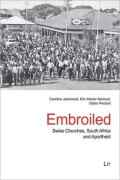In this recently published book on the involvement of Swiss religious organisations in the struggle against apartheid, the authors explore an original and, so far, one of the premier terrain that linked Switzerland to South Africa. It stresses how Swiss churches dealt with the South African institutionalised racism implemented through the National Party and its apartheid policy after World War II. This entry through religious relationships between the two countries renews the debate that has been almost exclusively focused on banking and financial or economic relationships. Beyond the involvement of Swiss Churches against the apartheid policy, this book tackles a thematic frame, which points out the deep influence that the Swiss had on people and on the wider society in the northern part of South Africa. The book’s two main topics – the Swiss cultural influence on local people and the fight against apartheid – bring great insights on what has been called the ambiguous missionary, meaning all contradictory dynamics the Swiss religious institutions went in with regards to South Africa.
The 373 pages of this volume are divided into eight chapters. There is a certain imbalance between chapters, with the introductory and concluding chapters having twelve and five pages, respectively, while chapter two runs to 81 pages and chapter five to thirty. Critically, the introductory chapter gives an overview of relationships between Switzerland and South Africa, from the Swiss emigration in the subcontinent in the 19th century to the end of apartheid in the late 20th century. It then turns to an outline of chapters two to seven. Chapter two focuses on Education, Land and Health Care up to the beginning of apartheid in 1948. At that stage, the study emphasises the perception of Africa and Africans by the Swiss, and the role played by the Swiss in ‘assisting’ Africans “to raise themselves to a higher level of development” (p. 25). Chapter three deals with the Swiss Mission facing apartheid and its lateral drawbacks such as the nationalisation of missionary schools (1950s) and hospitals (1970s) as well as the removals of people. It shows the Swiss dilemma between coping with the racist regime and opposing it (p. 98). There is also a clear analysis of how Swiss missionaries tried to negotiate the status of their former schools and health care facilities in rural South Africa. Chapter four links the church, apartheid and the issue of ethnicity that was in a certain way encouraged by both the Swiss mission and the apartheid government with completely different ends. While Swiss missionaries regarded people they came to call the Tsonga, as those to whom they were especially responsible, the apartheid government pushed ahead the politics of ethnicity, aiming at the dividedness and the weakening of Africans. There was a kind of confusion between church and the state that is clarified by the authors. Chapter five shows how, through faith-based organisations, apartheid became a significant issue in Switzerland. It analyses the methods that were used to make people aware of as well as to react to both the immoral reality of apartheid and the rising contestation of the support paid to the racial policy by certain Swiss public and private institutions. Chapter six is about the ways and means of contesting apartheid. It appears that the confrontational stance adopted by the World Council of Churches and launched in 1969 as the Programme to Combat Apartheid created various reactions amongst people and organisations in Switzerland. Indeed, the federation of Swiss Protestant Churches, for example, chose moderation, and so, fought on the field of human rights while the others preferred to confront the ‘evil in a more direct and practical way’. Chapter seven addresses divisions amongst the Christian community in Switzerland, and the divisions of Swiss Churches on the issue of sanctions against the apartheid regime, as some preferred negotiation to confrontation. Nevertheless, it is clear that various and varying actions and reactions amongst Swiss anti-apartheid people and organisations were mostly due to Swiss economic interests in South Africa. Indeed, ‘‘Switzerland (was) the only western country which refused to impose sanctions on South Africa and whose three large banks – the Union Bank of Switzerland (UBS), the Swiss Bank Corporation (SBC) and Crédit Suisse (CS) were amongst the main international institutions providing funds to South Africa’’ (p. 273). The eighth and final chapter recaps some of the book’s conclusions. Thus, it confirms the hypothesis that Swiss religious organisations played a momentous role, not only in linking Switzerland to South Africa, but also in opposing apartheid, and preserving the Christian ideal of brotherhood beyond races.
In confirming this hypothesis, the authors have succeeded in demonstrating that Switzerland did not only benefit from the financial relationships with the racial and rich South African regime developed by the winning National Party in 1948. While economic and financial relationships with South Africa provided Switzerland with more than the annual 300 millions Swiss francs that represented the limit of investments fixed by the Swiss federal council in 1980, religious relationships enabled Swiss Churches and other organisations to participate in the dismantling of apartheid.
In spite of the mentioned imbalance between chapters, and other small quibbles and pitfalls that may be due to the editing and the re-editing processes, Caroline Jeannerat, Eric Morier-Genoud, and Didier Péclard offer to the reader an analytical and well-written text that every specialist of the transnational history of Switzerland, and all persons interested in the history of relationships between Europe and Africa need to read.
Zitierweise:
Hines Mabika: Rezension zu: Caroline Jeannerat, Eric Morier-Genoud, Didier Péclard: Embroiled: Swiss Churches, South Africa and Apartheid. Zürich/Berlin, Lit Verlag, 2011. Zuerst erschienen in: Schweizerische Zeitschrift für Geschichte Vol. 62 Nr. 3, 2012, S. 516-518
